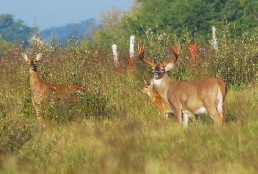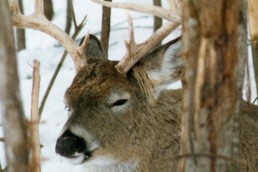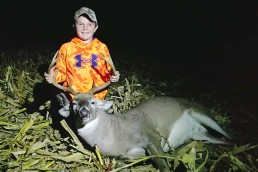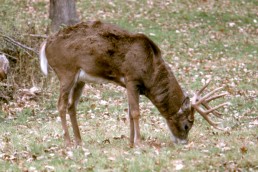How to Defeat a Buck’s Bankroll: Its Nosy Nose
SHARE THIS POST
If there’s one element that can ruin any deer hunt, it has to be the exceptional sensitivity of a whitetail’s nose. This is a given because a deer’s nose is super-sensitive. It’s like the engine in your vehicle—it keeps you going. So too, the whitetail’s nose is the foundation of its daily survival.
Call me careless. Maybe I was, but I blamed the wind and its fluctuating directions when a chocolate-brown buck “winded” me with a reaction that seemed almost supernatural. The fat, six-point buck was not a “shooter” size trophy. But he was what I call a “learning buck,” because I could watch him to view how he reacted to any mistakes I made. I believe I had prepared my hunting set-up in my favor. But I realized, as human as I am, I’m never as astute as I should be. As a hunter, I constantly remind myself that any deer I pursue is far more intimate with its home grounds than I will ever be.
I knew I was in trouble when the buck displayed vertical head bobs and side-to-side tail flips. He was using several body parts as he flicked his ears erratically. I knew he was alarmed when he stomped his right-front leg sternly; he was nervous. I was certain his actions were based upon the fact he couldn’t visually identify an intruder. Although I was camouflaged and downwind, I realized we hunters never determine to what degree we are ahead of the game. This is a reason whitetails are survivalists. They are without a doubt, a product of their own environment.
Then he raised his head upward, flaring his nostrils and licking the end of his nose. His instincts and senses informed him I didn’t belong within his home grounds. The wind swirled in his favor and he bolted into dense cover.
There should be no doubt in any deer hunter’s mind how wind direction and intensity impacts success. Wind carries human scent to the sensitive whitetail nose. Wind can be ruination for hunters because it’s usually responsible for deer pinpointing us, and it is not always constant and will shift and swirl within minutes.
Fortunately, hunters are highly competitive. We reply upon our experiences, skills, social contacts and wits to achieve successes. But, so do deer. That’s why we should constantly change our hunting tactics to develop the best methods of tagging whitetails. Often, we believe we are the greatest life forms on this earth and hunting deer is second nature. But whitetails prove otherwise, because deer have one “sense” that humans aren’t 100 percent successful at: deceiving.
It’s a proven fact that of all the senses deer possess, their “nose” (smell) is premiere. Therefore, how does it work? How can hunters control or mask their odors? Obviously, we must become as scent-free as possible and become students of wind direction.
Are you enjoying this post?
You can be among the first to get the latest info on where to go, what to use and how to use it!
To understand how a deer’s nose works, one wildlife biologist explains that a deer’s nostrils are lined with epithelium, which contains mucous membranes and sensory nerve endings. Responses to any chemical odors are carried through sensory nerves to the olfactory bulbs. (A deer’s olfactory bulbs are larger than a human’s.) Then the olfactory bulbs send impulses to the brain stem. This is where and how an odor is identified.
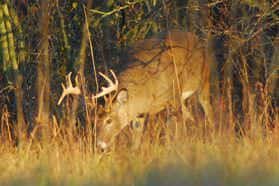
Super-sensitive noses of any species access odors in varying degrees. The epithelium that lines the interior of the deer’s nose helps identify the odor. Scientists and biologists believe that many natural variables are monitored by a deer’s nose. Wind, temperature, and moisture are associated with and combine into a definition of any odor. Deer’s scenting abilities and perceptions are also heightened by a warm, moist, still atmosphere. Both rain and snow carry scent molecules to earth and will dilute them. Light mist and heavy fog also blocks scent from moving long distances. On the other hand, humidity in the 50 to 70 percent range is optimum for deer to smell effectively. High humidity seems to make deer skittish, and they are very alert. High temperatures cause air convections and rising thermals carry scent molecules upward before they reach ground level with deer.
Wind speed, direction, and landscape features must be assessed so our scent dispersal doesn’t spook deer. Any mature buck hunter who achieves constant success understands that wind rules a deer’s nose and its survival. Ever wonder why bucks prefer to travel below ridges and along the bottoms of valleys? Obviously, their concealment is more assured because they aren’t as skyline-visible as when they are exposed along the top of a ridgeline. And, wind currents across the sides of sloping hillsides are more directional. Deer are probably comfortable here and more apt to detect danger from above. Wind currents dominating the high points of ridges can be unpredictable. Therefore, deer seek habitats with more stable air currents.
Hunting open flatlands usually means more predictable wind directions. Landscape structures and features don’t alter the wind as erratically as very hilly, eastern Ohio terrain. But regardless of weather and terrain fluctuations, a whitetail’s nose is most often its savior—if deer couldn’t smell they would be much easier to tag.
Always keep a visual picture of a buck’s nasal sensitivity and remember every time any deer has winded you. Hunters are quickly reminded they must devise a routine that is defensive at deceiving a deer’s sense of smell. Make sure your hunting clothes are washed regularly with scent-eliminating detergents. Serious hunters refuse to use a clothes dryer and prefer to hang their hunting attire outdoors to dry. They attempt to keep their clothes as far away from human odors as possible. Dried clothing should then be stored in a large sealable plastic bag. Plastic tots work well too, and can be used to transport clothing to your hunting location. Very important: Don’t wear any hunting clothing while you’re at home, or driving to your hunting spot. Dress after you arrive, outside you vehicle. Also, never run errands before hunting, such as pumping gas, stopping at a convenience store, etc. because deer deplore human odors.
There are numerous methods for covering one’s scent or minimizing odors. Commercial de-scenting products have come a long way. But, remember where you intend to hunt. If you stand-hunt within pines, mimic natural odors associated with the habitat. You can cut and include a few pine sprigs in your clothing container. A bowhunter who hunts a mucky creek bottom might place earth at the bottom of his container, cover the dirt with a sheet of plastic and add his hunting clothing. But no matter how well we de-scent our clothing, our bodies must be carefully washed of human scent. Never forget, your body constantly emits various odors.
Modern ScentLok suits are believed to control human body odors. Also, try de-scenting sprays misted upon clothing before hunting. These solutions are believed to help neutralize our human odors. Deceiving a deer’s nose is a constant battle. Therefore, we must always try to manage our scent because deer are super-sensitive to odors. But above all else, using the wind in our favor is our ally.
MWO
SHARE THIS POST
Did you enjoy this post?
You can be among the first to get the latest info on where to go, what to use and how to use it!
Bob Grewell
Bob “Greenie” Grewell has written about and photographed the outdoors for 40 years. He’s travelled throughout the U.S., Canada, the Arctic Circle, as well as Germany and Denmark. He has written a book on hunting dogs and contributed articles and photography to others. He currently focuses on deer and turkey articles, and wildlife photography.
